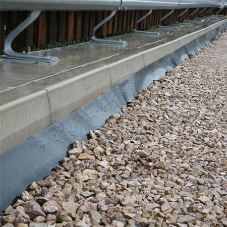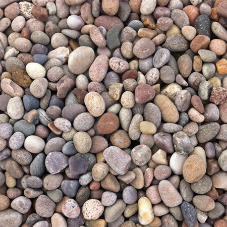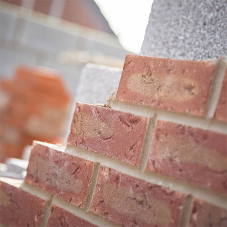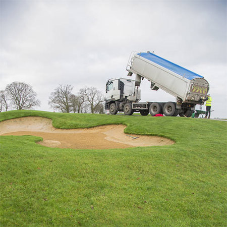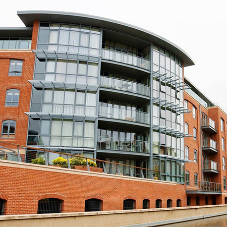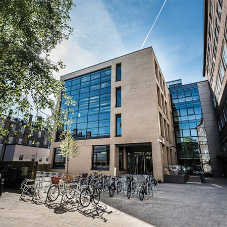The colder months are here to stay until Spring and working outdoors can be more difficult given the drop in temperature. The cold can create a wide array of issues but, with the right planning, there’s no need for your projects to be disrupted. Good organisation can help avoid unnecessary problems such as frost damaged equipment, cracked concrete and in turn, wasted product.
To combat the negative impact that freezing temperatures can have on your build, here are five key pieces of advice from Ross Bangs, professional landscaper and Tarmac Blue Circle Ambassador.
1. Take care of yourself first
It’s a well-known fact that accidents increase on construction sites during the autumn and winter months as the days become darker, wetter and colder. So, it may seem obvious but when working outdoors in the winter, it’s important to make sure you keep warm in order to stay safe and continue working to a high standard. The simple way to do this is to dress appropriately for the weather, so you should look to incorporate the following into your workwear:
• Insulated gloves – a necessity during cold conditions and there is a variety of different styles to choose from so it should be fairly easy to find a style that suits both the work and worker’s protective needs.
• Hard hat liners – don’t forget that you should never swap your hard hat for a knitted one. Instead look for hard hat liners that will keep your head, neck and ears warm while still being able to wear your hard hat.
• Layer, layer, layers! – A multi-layering approach is crucial for keeping warm. Consider layers that will keep your skin dry, insulate your body and block the wind.
• Work boots – These are a crucial part of your personal protection equipment however, in the winter it’s important to fulfil another role. One of the quickest ways you lose heat is through wet feet and therefore investing in waterproof safety boots is very important. Winter boots often allow more space for thicker socks too!
2. Keep your toolkit fit
We all know that a good, sturdy tool can make or break a project, so it’s essential to take good care of your tools during the winter. Don’t ever leave them outside in the damp weather, as they are likely to rust. To keep them in tip top condition and ensure your tools last as long as possible, make sure they are stored correctly, cleaned, lubricated and sharpened regularly. Not only will this keep them in perfect working order but prevent the painstaking job of chipping away at hardened dirt or mortar and removing rust later down the line, or worst case scenario, having to buy new equipment.
3. Keep an eye on the weather forecast
Cold weather itself is enough to hinder a project but winter brings with it a multitude of other challenges such as rain, wind and show so it’s crucial that these features are considered when preparing to work in winter.
Severe wind can cause premature drying so consider putting up wind barriers to protect your work. Rain and snow can also cause problems as it may contain contaminants that affect how the concrete cures so always ensure your work is covered with a tarpaulin or a waterproof sheet.
Remember to check your equipment for frost and keep it well away from your project to avoid your hard work being ruined.
Always remember, mortar should be kept moist for 36 hours to allow it to fully cure. However, too much moisture caused by heavy downpour could weaken the surface and cause serious problems in the future. Avoid this with a water-resistant tarp or plastic sheeting to slow down the curing process and help form a strong bond.
4. Take the time to understand your products
When working during the winter, the quality of your concrete matters more than ever. Always look for a good quality product and one that’s air entrained as it will have far greater frost resistance.
Additionally, packaging is much more important during the colder months. Cement can spoil quickly when left outside due to rainwater contamination, damp and damage. To prevent this, choose a concrete that comes in a tub or tear and weather resistant packaging, such as Tarmac Blue Circle Mastercrete Cement. This advice may seem simple but can save a lot of cost and frustration down the line.
5. How cold temperatures effects your work
Extreme weather and temperature can play a large role in the usability and strength of concrete. For instance, if newly placed concrete falls below zero degrees prior to developing enough strength, the water in the mix will freeze and expand. This will result in the cracking, scaling and crumbling of the concrete. It’s recommended to only work with concrete in temperatures above five degrees however, this isn’t always an option during the winter months when there is a risk of frost. To protect your mortar, use an insulation quilt sandwiched between two sheets of polythene sheeting for at least 48 hours after the concrete has been placed to ensure adequate heat for normal cement hydration.
For further information on Tarmac Blue Circle, please visit https://tarmac-bluecircle.co.uk/
Working in the colder months
Products by this Company
Categories
Safety Building areas and systems, concrete Cement



